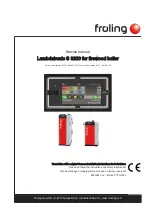
41
6
+1
0
4
+0.5 0
10
±0.5
A
A
B
5
+3
0
Fig. 31
A
Ignition electrodes
B
Ionisation electrode
1.
Check the electrodes for wear and contamination.
2.
Clean the electrodes with a small brush (not with a
wire brush) or sandpaper.
3.
Check the electrode gaps. If the gaps are not as
specified or the electrodes are damaged, replace
the electrodes together with new gaskets and
adjust them as required. Tighten the electrode fix-
ing screws with 4.5 Nm.
Cleaning the heating surfaces
!
Please note
Scratches to the surfaces of the heat exchanger
that come into contact with hot gas can result in
corrosion damage. Brushing can cause deposits
to become lodged in the gaps between the coils.
Never use brushes to clean the heating sur-
faces.
!
Please note
Prevent damage due to cleaning water.
Cover electronic components with suitable
watertight material.
Note
Discolouration on the heat exchanger surface is a nor-
mal sign of use. It has no bearing on the function and
service life of the heat exchanger.
The use of chemical cleaning agents is not required.
A
Fig. 32
1.
Use a vacuum cleaner to remove combustion resi-
dues from heating surface
A
of the heat
exchanger.
2.
Flush heating surface
A
with water.
3.
Check condensate drain. Clean the trap: See the
following chapter.
Checking the condensate drain and cleaning the trap
Flue gas cascade:
clean the trap in the flue gas header as well.
Commissioning, inspection, maintenance
Checking and adjusting the ignition and ionisation electrodes
5778741
















































